I recently led my fourth workshop to Peru, and it’s become one of my favorite trips. There are a lot of reasons why: it’s easy to get to (no jet lag), the food is good, prices are reasonable and there’s amazing history and culture. But the main reason is the people. They’re open and friendly and live a lifestyle nothing like ours. Which makes for great experiences and pictures. Here’s a day-to-day breakdown of how the trip goes:
Day 1 – Fly to Lima, Peru. Since Lima is our jump-off point for the trip, we really just need to get some sleep before flying down to Cusco the next morning. So we stay at the airport hotel, which is literally 50-yards from baggage claim. I love easy!
Day 2 – Our day starts with an early flight from Lima to Cusco. Which means we’re going from sea level to 11,200-feet. That’s some serious altitude, so you won’t be doing any running, and headaches are likely. Because of that I have everyone take headache medicine (whatever works for you) on the flight down. Once arriving, we head to lower altitudes, towards Urubamba and about 9000-feet. We also meet up with our guide after landing at Cusco, and he’s the most important part of the trip. I always work with a local guide on international trips, and a good guide is key to a great trip. We had one of the best there, Efrain Valles, “Effie.” He’s the quintessential guide. Grew up there, knows people in every town and village we visit, excellent English skills and comprehensive knowledge of Peru’s history and culture. Most importantly, he understands what we want in a trip as photographers. We’re not a normal tour, and if the guide doesn’t understand that, it will be frustrating for all of us. Fortunately, Effie does, which means we’ll have a great workshop. Plus, he’s a lot of fun to be around. We’ll make a few stops that first day driving down into the valley, but my favorite is at a local wildlife recovery center. I love those Peruvian hairless dogs!
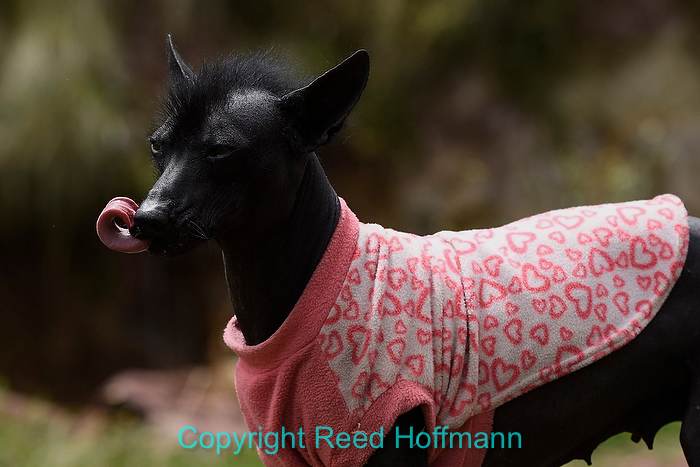
Yes, believe it or not, the Peruvian hairless dogs have mohawks! Nikon D7200, Aperture Priority, white balance of Sunlight, ISO 200, 1/1250 at f/4, EV -1.0, Nikkor 70-200mm f/2.8 lens at 120mm. Photo copyright Reed Hoffmann.
Day 3 – First thing today is a trip to Pisac to visit the ruins. But this is also the day of the big weekly market in Urubamba, so we shift our schedule to make sure we return in time to visit. And it’s wonderful. This is a local market, not a tourist one, so people come from the mountains – sometimes walking up to four hours – to buy and trade everything from food and livestock to clothing and toys. We start as a group, with Effie breaking the ice to make it easier to take photos. Then we scatter, so everyone can do their own photography. My favorite place was up a small hill where the animals were kept. From chickens and geese to pigs, sheep and cows, people came and went, buying and selling. In the afternoon we went for a short hike and then visited a local brewery (translation – a local lady’s home) to learn about and try the local corn beer (chichi).

Wednesday morning market in Urubamba. I wanted make a photo that gave a feel for the size of the market, and seeing this lady coming up the hill, knelt, framed my picture and waited for her to walk into it. Nikon D750, Aperture Priority, white balance of Sunlight, ISO 125, 1/1000 at f/6.3, EV -0.3, Nikkor 24-70mm f/2.8 lens at 24mm. Photo copyright Reed Hoffmann.
Day 4 – This was our day to visit the weaving center of Chincheros, the circular ruins of Moray and the salt pans of Maras. While the weaving demonstration is fascinating (they use bugs, among other things, to create dye), it took place in an area with poor light. Just behind there, though, was a lovely wall with a nice edge of sunlight. Once the demonstration was over, I asked if one of the women would stand there, and gave a short lecture on light and background. This is a workshop, after all! Following a short walking tour of the town, we headed to our picnic lunch at the ruins, and then to the salt pans before sunset. I love this spot because it demonstrates man’s ingenuity. A stream coming out of the mountain is rich in salt, so about six-hundred years ago people started terracing the hillside and creating a series of shallow pools. Water is collected in them, allowed to evaporate, and voila, the people have salt. They still do that today, and the salts from there are famous across Peru.
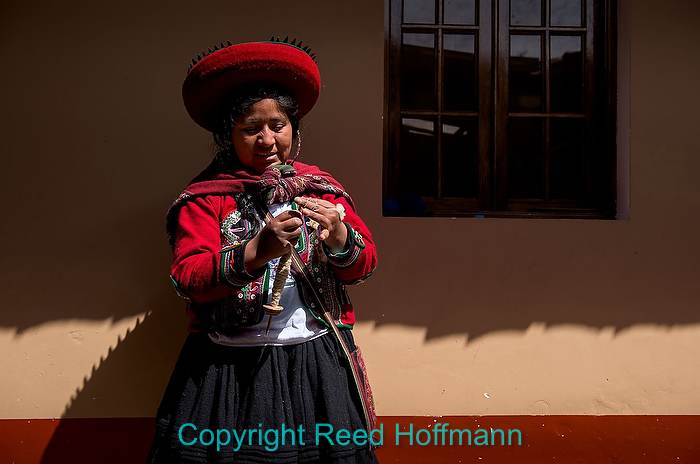
Location, light and background all came together to make this picture. Nikon D750, mode, white balance of Sunlight, ISO 100, 1/640 at f/5, EV -1.0, Nikkor 24-70mm f/2.8 lens at 35mm.Photo copyright Reed Hoffmann.
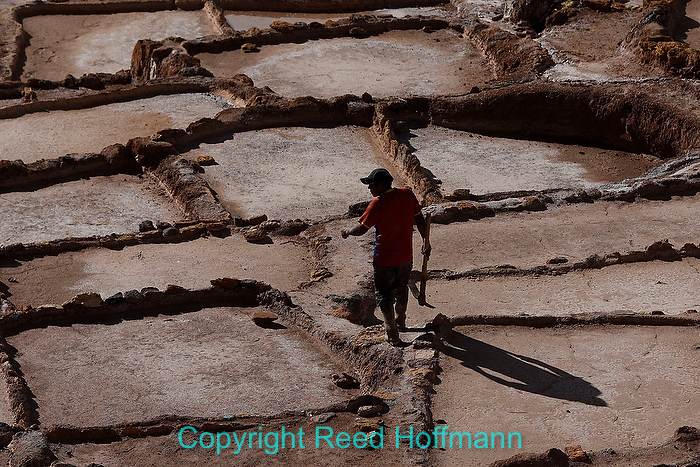
The salt pans at Maras date back to the middle of the second millennium, and are still in use today. Backlight makes this picture more dramatic by creating shadows off the man and the edges of the pools. Nikon D7200, Aperture Priority, white balance of Sunlight, ISO 200, 1/2500 at f/5.6, EV -1.0, 70-200mm f/2.8 Nikkor lens at 155mm. Photo copyright Reed Hoffmann.
Day 5 – After a night in Ollantaytambo, we spend the morning touring the massive Incan ruins there as well as the town. After lunch, we board our train to Machu Picchu. Most people visit Machu Picchu as a day trip from Cusco, which means they come down in the morning, spend a few hours, then leave mid-afternoon to return. That’s why we plan our day to arrive there mid-afternoon, when most of the crowd is leaving. Thanks to the surrounding mountains, the area often has clouds. Which means we have a couple of hours to pray for great afternoon light before they chase us out and close for the day. Our prayers were answered, with perfect light just fifteen minutes before closing. That made for a happy group at dinner that night.
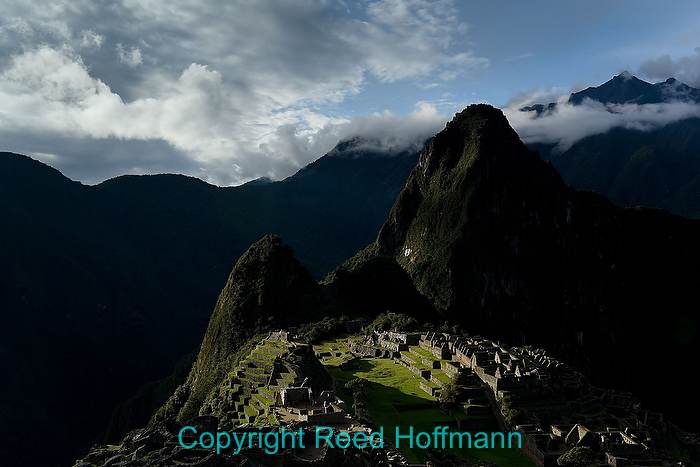
Seeing Machu Picchu, especially in the last light of the day, makes you realize why the Incas built it there. Nikon D750, Aperture Priority, white balance of Sunlight, ISO 200, 1/640 at f/5.6, EV -1.3, 24-70mm f/2.8 Nikkor lens at 34mm. Photo copyright Reed Hoffmann.
Day 6 – You have to suffer for your art, right? In this case that meant a 4:30am walk from our Machu Picchu hotel to the buses. They start taking people up to the ruins at 5:30, and unless you want to be far, far back in line, you need to get there early. We made it onto the first couple of buses, which put us at the overlook well before the sun. As it crested the mountains east of us, we were treated to another spectacular show, this time with clouds rolling across the ruins as the light crept across the scene. A perfect sunrise to follow the perfect sunset the previous evening. After that, our group had two choices: either a detailed tour of the ruins with Effie, or climb Huayna Picchu. It’s that iconic mountain behind Machu Picchu, and despite being my fourth time there, I’d never had the opportunity to climb it before. This time, with perfect weather and two of the group wanting to go, we went. It’s a steep, slow climb, and while the altitude is “low” for the Sacred Valley, we’re still at 8000-ft. But the views back to Machu Picchu are wonderful, and going slowly, we made it both up and back in a few hours. After a short tour of the main ruins with Effie, we re-joined the others down below in town for lunch before our train (and then bus) trip to Cusco that evening.
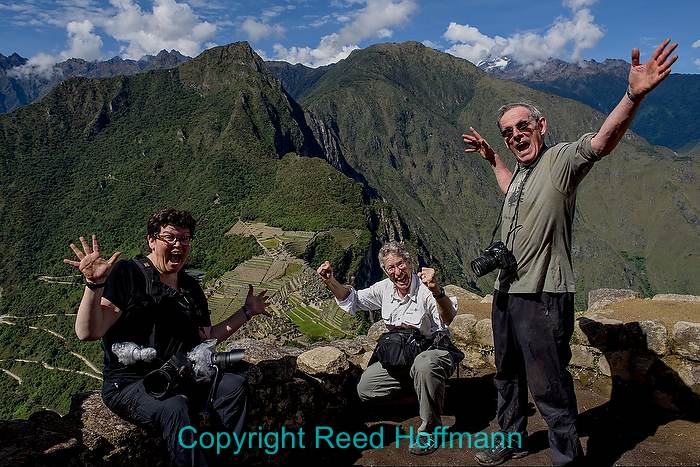
Kellie and Mark celebrate with me after reaching the top of Huayna Picchu, with a great overview of Machu Picchu in the background. Nikon D750, Aperture Priority, white balance of Sunlight, ISO 100, 1/250 at f/8, EV -0.3, Nikkor 24-70mm f/2.8 lens at 27mm. Photo copyright Reed Hoffmann.
Day 7 – Now back in Cusco, we’re feeling that 12,000-ft of altitude. Perfect time for a day off. This is officially a rest day, allowing the group to sleep in and go shopping. However, being a photo group, few take that option. Instead, most of us meet at the town square for the weekly parade at 10am. It’s a fun event to photograph, and there’s always at least one group of dancers there. Afterwards we had lunch on the square, then people either went shopping or back to the hotel for naps.
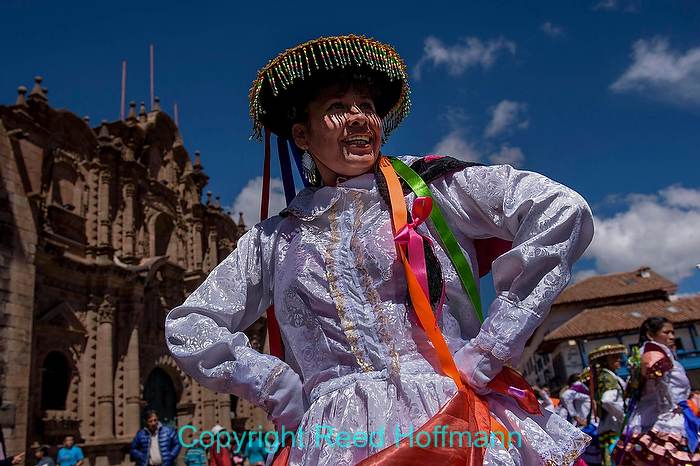
This picture stands out because of the light in the dancer’s face, during the Sunday morning parade in Cusco. Nikon D750, Aperture Priority, white balance of Sunlight, ISO 125, 1/1600 at f/5.6, EV -0.7, 24-70mm f/2.8 Nikkor lens at 28mm. Photo copyright Reed Hoffmann.
Day 8 – There are two ways to get to Puno from Cusco. You can take a 6-hr. bus ride or a 10-hr. train ride. In the past we’ve taken the train, but in April of 2018 we’re going to take the bus instead. That will give us some opportunities to stop and take pictures in the scenic areas we pass through, and get us to Puno earlier.
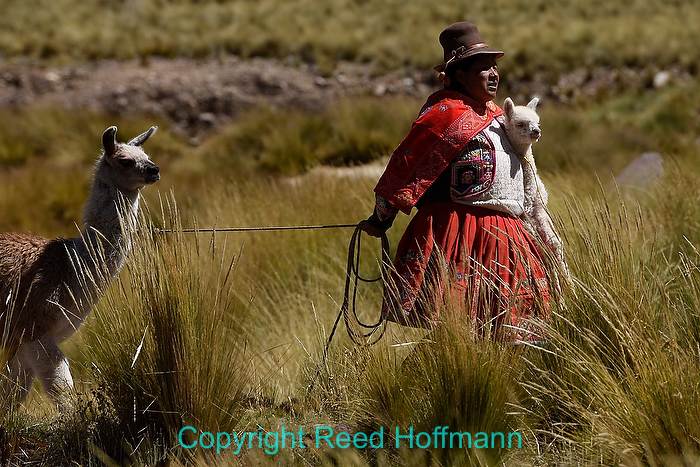
The area between Cusco and Puno offers some great opportunities to see, and photograph, daily life in Peru. Nikon D7200, Aperture Priority, white balance of Sunlight, ISO 320, 1/2500 at f/5.6, EV -1.0, 70-200mm f/2.8 Nikkor lens at 200mm. Photo copyright Reed Hoffmann.
Day 9 – This morning we’ll take a tour boat out onto Lake Titicaca, the highest “navigable” lake in the world (12,500-ft!). First stop is a visit to the Uros islands. These are reed islands that are literally floating on the lake. It’s believed that the people who first started living on them did that as a way to escape invading groups on land. Their descendants still live on reed islands, making a living through fishing and weaving. We have a nice tour of one of the small islands by the family that lives there, including a short excursion on one of their reed boats. Then it’s back to our tour boat for the trip out to Tacquile Island. From it we can see the snow-covered mountains of neighboring Bolivia, and have lunch with a local family. After another short tour of the island, we return to the boat for our trip back to Puno.

Out for a morning row on Lake Titicaca with two Uros islanders. Like the dancer shot above, the light in their faces, against the dark blue sky, makes the picture. Nikon D750, Aperture Priority, white balance of Sunlight, ISO 200, 1/500 at f/11, EV 0.0, 24-70mm f/2.8 Nikkor lens at 29mm. Photo copyright Reed Hoffmann.
Day 10 – This is our final day in Peru, and while it could just be a travel day, that would be a waste. Instead, we leave Puno early and drive out to the Silustani ruins. There we see well-preserved circular burial chambers that pre-date the Incas. From there we go Juliaca for our flight back to Lima, stopping along the way to meet and photograph a family on their small farm. Landing in Lima mid-afternoon, we have a lot of time to kill before our late-night flights back to the states. So we’ve organized an optional tour of the city. Most of the group joins, so we see the old main square, a monastery, the Larco Museum and finish with a wonderful dinner on the ocean. We’re back to the airport in plenty of time for our overnight flights, and tired enough to actually sleep on them!
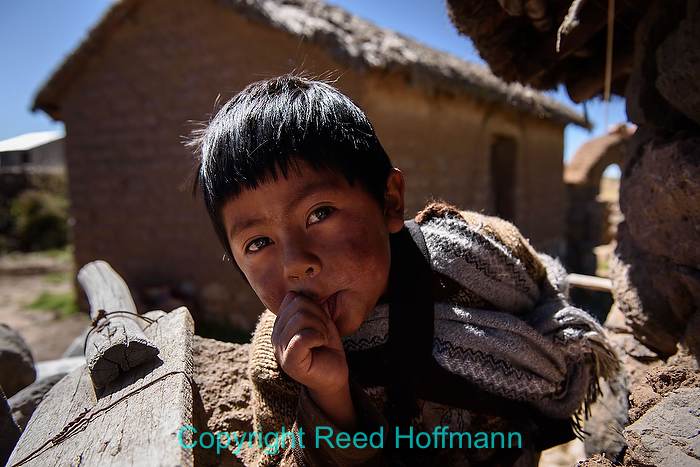
Our last stop was to visit this family farm near the Silustani ruins. Getting close to the boy, with a wide-angle lens at wide aperture, allowed me to throw the background out of focus. Nikon D750, Aperture Priority, white balance of Sunlight, ISO 125, 1/320 at f/5.6, EV -0.3, 24-70mm f/2.8 Nikkor lens at 32mm. Photo copyright Reed Hoffmann.
If you’ve never been to Peru, put it high on your list of “must go” places. While Machu Picchu is well deserving of its place among the Seven Wonders of the World, the people there are the true treasure. And if you’d like to go with me, I’ll return again in April of 2018. Happy to have you along!
(You can see more photos from this trip at https://reedhoffmann.com/2016Peru/. If you enjoy reading these stories, please tell your friends. I also post links to interesting stuff happening in photography at http://www.facebook.com/KCphotographer)

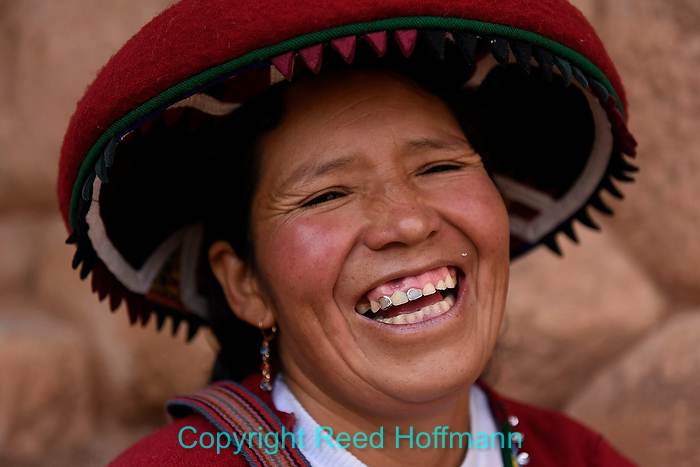
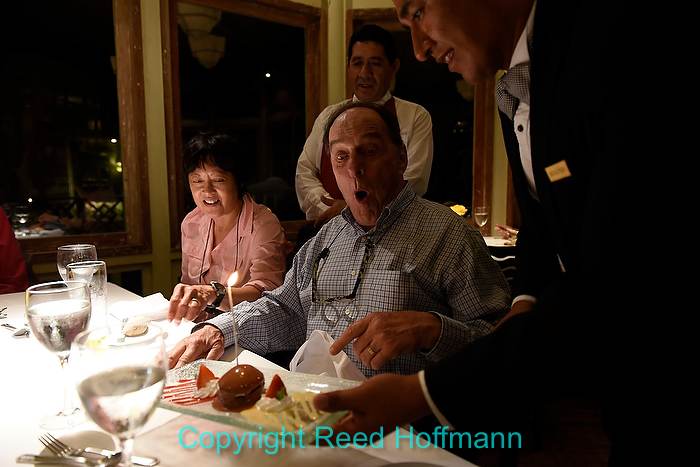
Trackbacks/Pingbacks